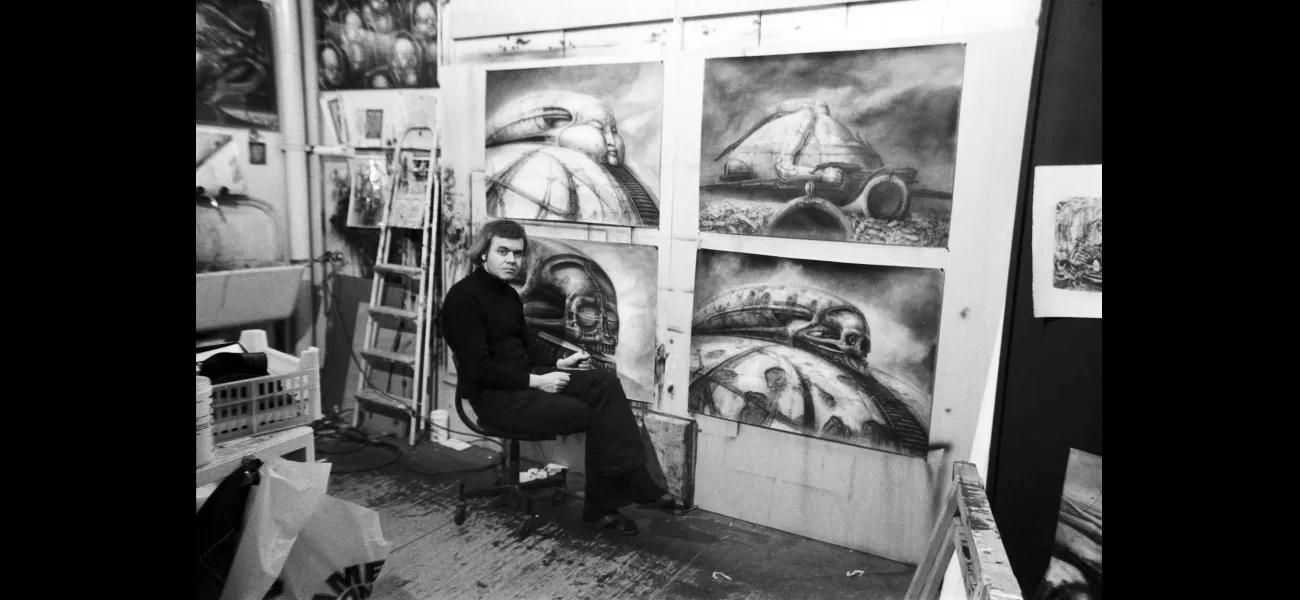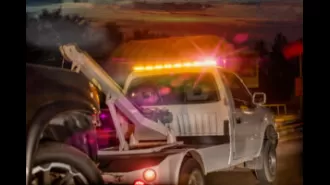Dune 2 hailed as a masterpiece, but the ultimate adaptation was never created.
This version doesn't have Zendaya or Timothée Chalamet, but it does have Mick Jagger and Salvador Dali.
February 16th 2024.

H.R. Giger, the renowned artist, was surrounded by some of his stunning concept art for Jodorowsky's Dune. The anticipation for the release of Denis Villeneuve's Dune 2 is already high, with many calling it a "sci-fi masterpiece". However, there are still those who believe that the best adaptation of Frank Herbert's novel is one that has never been seen before.
We're not talking about the unsuccessful attempts of the past, like David Lynch's 1984 version, which was a box office disaster, or the 2000 miniseries that received little attention when it aired on the US SciFy channel. No, we're referring to a film that was never even made. Yes, you heard it right - a movie that no one has ever laid their eyes on. We're talking about Alejandro Jodorowsky's ambitious film adaptation that was planned in the 1970s, but never fully realized.
You might be wondering, what could be so great about a movie that doesn't exist? Well, let us give you a glimpse of the unbelievable details. The star-studded cast included names like Orson Welles, Salvador Dali, and Mick Jagger. The iconic band Pink Floyd signed on to create the soundtrack, and the film was intended to be at least 10 hours long. Jodorowsky's vision was to create a cinematic experience that would feel like an LSD trip. It's no wonder that the "bible" containing all the details of Jodorowsky's concept has reached almost mythical status among movie enthusiasts.
Now 93 years old, Jodorowsky is a Chilean director who made his mark in the theater world before rising to international fame in the 1970s with his surreal masterpieces, El Topo and The Holy Mountain. The bizarre El Topo is often credited with popularizing the "midnight movie" phenomenon, with its late-night screenings drawing huge crowds in New York City in 1971. Even John Lennon and Yoko Ono were among the audience at one of those screenings, and Lennon was so inspired that he instructed his manager to give Jodorowsky one million dollars to fund his next film, which turned out to be The Holy Mountain.
It's not just Lennon who was influenced by Jodorowsky's work. Other visionaries such as Bob Dylan, David Lynch, Erykah Badu, Roger Waters, and Kanye West have all credited him for opening their minds and inspiring their work. In fact, George Harrison was set to star in The Holy Mountain, but as Jodorowsky revealed in an interview, the Beatle refused to show his anus on camera, which was a major artistic difference for Jodorowsky.
After the success of The Holy Mountain, famous French producer Michel Seydoux offered to fund Jodorowsky's next project in 1974. The eccentric director chose to take on the daunting task of adapting Frank Herbert's complex novel, Dune. And that's where the legend of the greatest movie that was never made begins.
With Seydoux's backing, Jodorowsky wrote a script that was as thick as a shoebox and assembled a team of collaborators, whom he called "spiritual warriors". He also enlisted the help of renowned artists like Jean 'Moebius' Giraud from France, H.R. Giger from Switzerland, and Chris Foss from Britain, to create concept art that is still talked about today. Each artist was assigned a specific task, with Foss designing the various space crafts in the novel.
Foss, who is best known for his illustrations in The Joy of Sex, was given the task of bringing the spaceships to life in a visually striking way. Years later, when asked to describe what he had told Foss he wanted in an introduction to a compilation of Foss's work, Jodorowsky said: "I wanted jewels, machine-animals, soul-mechanisms, womb-ships, antechambers for rebirth into other dimensions, whore-ships driven by the semen of our passionate ejaculations, humming-bird ornithopters which fly us to sip the ancient nectar of the dwarf stars giving us the juice of eternity, caterpillar-tracked hot rods so vast that their tails would disappear behind the horizon, machines greater than suns wandering crazed and rusted, whimpering like dogs seeking a master, thinking wheels hidden behind meteorites, waiting, camouflaged as metallic rocks, for a drop of life to pass through those lost galactic fringes to quench thirsty tanks with psychic secretions."
The storyboard for the film was filled with stunning illustrations by Moebius, H.R. Giger, and Chris Foss. Giger, who is often credited with creating the iconic sci-fi aesthetic, described his concept for Castle Harkonnen as a structure made of "jagged bones and excrement". While this gives us some insight into what the movie might have looked like, we can also look at the script of a familiar movie to get a sense of Jodorowsky's writing style. He had the help of screenwriter Dan O'Bannon, who went on to write the sci-fi classic Alien in 1979.
It's safe to say that Jodorowsky took the project very seriously. He famously said, "For me, Dune will be the coming of a god", which shows the magnitude of his vision for the film. Unfortunately, the project never came to fruition, leaving behind only the "bible", filled with art and ideas that continue to fascinate and inspire generations of movie lovers.
When we think of the best adaptations of Frank Herbert's novel Dune, we often think of the upcoming film directed by Denis Villeneuve. But there's one adaptation that remains a mystery to most, as it was never actually made. We're talking about Alejandro Jodorowsky's visionary 1970's film that was never fully realized.
Jodorowsky, a Chilean director known for his surrealistic style, had already gained international acclaim for his films El Topo and The Holy Mountain. These bizarre and mind-bending movies were credited with creating the "midnight movie" phenomenon, with lines around the block for late-night screenings in New York City. Even John Lennon was so inspired by Jodorowsky's work that he offered to fund his next film with a million dollars.
And that's where the legend of Jodorowsky's Dune begins. With the backing of a famous French producer, Jodorowsky set out to create a film adaptation that would push the boundaries of cinema. He assembled a team of collaborators, including artists Jean 'Moebius' Giraud, H.R. Giger, and Chris Foss, to create concept art that is still widely discussed today.
Moebius, Giger, and Foss were each tasked with designing different elements of the Dune universe. Foss, known for his illustrations in The Joy of Sex, was responsible for creating the striking visuals of the space crafts in the novel. Jodorowsky described his vision to Foss as "jewels, machine-animals, soul-mechanisms...whore-ships driven by the semen of our passionate ejaculations." It's clear that Jodorowsky had a unique and vibrant vision for the film.
But perhaps the most intriguing aspect of Jodorowsky's Dune was the star-studded cast he had assembled. Orson Welles, Salvador Dali, and Mick Jagger were just a few of the names attached to the project. And the soundtrack was set to be composed and performed by none other than Pink Floyd.
Despite all of this, the film was never made. The script, which reportedly took up an entire shoebox, and the "movie bible" containing all of Jodorowsky's concepts and details, have reached almost mythical status among movie enthusiasts. The only evidence we have of this ambitious project are the incredible concept art and interviews with Jodorowsky himself.
It's clear that Jodorowsky was taking this project very seriously, even going so far as to enlist the help of screenwriter Dan O'Bannon (who would later go on to write the iconic sci-fi film Alien). Jodorowsky's dedication and passion for Dune were evident, with him reportedly saying, "For me, Dune will be the coming of a god." And with his unique vision and talented team, it's not hard to imagine that the film would have been a mind-blowing experience.
It's a shame that Jodorowsky's Dune was never made, but it's clear that its legacy lives on. Not only did it inspire other filmmakers, such as David Lynch and Nicolas Winding Refn, but it continues to captivate the imaginations of film fans and sci-fi lovers alike. And with the newest adaptation of Dune set to premiere soon, it's a reminder of the incredible potential that Jodorowsky's version held.
We're not talking about the unsuccessful attempts of the past, like David Lynch's 1984 version, which was a box office disaster, or the 2000 miniseries that received little attention when it aired on the US SciFy channel. No, we're referring to a film that was never even made. Yes, you heard it right - a movie that no one has ever laid their eyes on. We're talking about Alejandro Jodorowsky's ambitious film adaptation that was planned in the 1970s, but never fully realized.
You might be wondering, what could be so great about a movie that doesn't exist? Well, let us give you a glimpse of the unbelievable details. The star-studded cast included names like Orson Welles, Salvador Dali, and Mick Jagger. The iconic band Pink Floyd signed on to create the soundtrack, and the film was intended to be at least 10 hours long. Jodorowsky's vision was to create a cinematic experience that would feel like an LSD trip. It's no wonder that the "bible" containing all the details of Jodorowsky's concept has reached almost mythical status among movie enthusiasts.
Now 93 years old, Jodorowsky is a Chilean director who made his mark in the theater world before rising to international fame in the 1970s with his surreal masterpieces, El Topo and The Holy Mountain. The bizarre El Topo is often credited with popularizing the "midnight movie" phenomenon, with its late-night screenings drawing huge crowds in New York City in 1971. Even John Lennon and Yoko Ono were among the audience at one of those screenings, and Lennon was so inspired that he instructed his manager to give Jodorowsky one million dollars to fund his next film, which turned out to be The Holy Mountain.
It's not just Lennon who was influenced by Jodorowsky's work. Other visionaries such as Bob Dylan, David Lynch, Erykah Badu, Roger Waters, and Kanye West have all credited him for opening their minds and inspiring their work. In fact, George Harrison was set to star in The Holy Mountain, but as Jodorowsky revealed in an interview, the Beatle refused to show his anus on camera, which was a major artistic difference for Jodorowsky.
After the success of The Holy Mountain, famous French producer Michel Seydoux offered to fund Jodorowsky's next project in 1974. The eccentric director chose to take on the daunting task of adapting Frank Herbert's complex novel, Dune. And that's where the legend of the greatest movie that was never made begins.
With Seydoux's backing, Jodorowsky wrote a script that was as thick as a shoebox and assembled a team of collaborators, whom he called "spiritual warriors". He also enlisted the help of renowned artists like Jean 'Moebius' Giraud from France, H.R. Giger from Switzerland, and Chris Foss from Britain, to create concept art that is still talked about today. Each artist was assigned a specific task, with Foss designing the various space crafts in the novel.
Foss, who is best known for his illustrations in The Joy of Sex, was given the task of bringing the spaceships to life in a visually striking way. Years later, when asked to describe what he had told Foss he wanted in an introduction to a compilation of Foss's work, Jodorowsky said: "I wanted jewels, machine-animals, soul-mechanisms, womb-ships, antechambers for rebirth into other dimensions, whore-ships driven by the semen of our passionate ejaculations, humming-bird ornithopters which fly us to sip the ancient nectar of the dwarf stars giving us the juice of eternity, caterpillar-tracked hot rods so vast that their tails would disappear behind the horizon, machines greater than suns wandering crazed and rusted, whimpering like dogs seeking a master, thinking wheels hidden behind meteorites, waiting, camouflaged as metallic rocks, for a drop of life to pass through those lost galactic fringes to quench thirsty tanks with psychic secretions."
The storyboard for the film was filled with stunning illustrations by Moebius, H.R. Giger, and Chris Foss. Giger, who is often credited with creating the iconic sci-fi aesthetic, described his concept for Castle Harkonnen as a structure made of "jagged bones and excrement". While this gives us some insight into what the movie might have looked like, we can also look at the script of a familiar movie to get a sense of Jodorowsky's writing style. He had the help of screenwriter Dan O'Bannon, who went on to write the sci-fi classic Alien in 1979.
It's safe to say that Jodorowsky took the project very seriously. He famously said, "For me, Dune will be the coming of a god", which shows the magnitude of his vision for the film. Unfortunately, the project never came to fruition, leaving behind only the "bible", filled with art and ideas that continue to fascinate and inspire generations of movie lovers.
When we think of the best adaptations of Frank Herbert's novel Dune, we often think of the upcoming film directed by Denis Villeneuve. But there's one adaptation that remains a mystery to most, as it was never actually made. We're talking about Alejandro Jodorowsky's visionary 1970's film that was never fully realized.
Jodorowsky, a Chilean director known for his surrealistic style, had already gained international acclaim for his films El Topo and The Holy Mountain. These bizarre and mind-bending movies were credited with creating the "midnight movie" phenomenon, with lines around the block for late-night screenings in New York City. Even John Lennon was so inspired by Jodorowsky's work that he offered to fund his next film with a million dollars.
And that's where the legend of Jodorowsky's Dune begins. With the backing of a famous French producer, Jodorowsky set out to create a film adaptation that would push the boundaries of cinema. He assembled a team of collaborators, including artists Jean 'Moebius' Giraud, H.R. Giger, and Chris Foss, to create concept art that is still widely discussed today.
Moebius, Giger, and Foss were each tasked with designing different elements of the Dune universe. Foss, known for his illustrations in The Joy of Sex, was responsible for creating the striking visuals of the space crafts in the novel. Jodorowsky described his vision to Foss as "jewels, machine-animals, soul-mechanisms...whore-ships driven by the semen of our passionate ejaculations." It's clear that Jodorowsky had a unique and vibrant vision for the film.
But perhaps the most intriguing aspect of Jodorowsky's Dune was the star-studded cast he had assembled. Orson Welles, Salvador Dali, and Mick Jagger were just a few of the names attached to the project. And the soundtrack was set to be composed and performed by none other than Pink Floyd.
Despite all of this, the film was never made. The script, which reportedly took up an entire shoebox, and the "movie bible" containing all of Jodorowsky's concepts and details, have reached almost mythical status among movie enthusiasts. The only evidence we have of this ambitious project are the incredible concept art and interviews with Jodorowsky himself.
It's clear that Jodorowsky was taking this project very seriously, even going so far as to enlist the help of screenwriter Dan O'Bannon (who would later go on to write the iconic sci-fi film Alien). Jodorowsky's dedication and passion for Dune were evident, with him reportedly saying, "For me, Dune will be the coming of a god." And with his unique vision and talented team, it's not hard to imagine that the film would have been a mind-blowing experience.
It's a shame that Jodorowsky's Dune was never made, but it's clear that its legacy lives on. Not only did it inspire other filmmakers, such as David Lynch and Nicolas Winding Refn, but it continues to captivate the imaginations of film fans and sci-fi lovers alike. And with the newest adaptation of Dune set to premiere soon, it's a reminder of the incredible potential that Jodorowsky's version held.
[This article has been trending online recently and has been generated with AI. Your feed is customized.]
[Generative AI is experimental.]
0
0
Submit Comment





